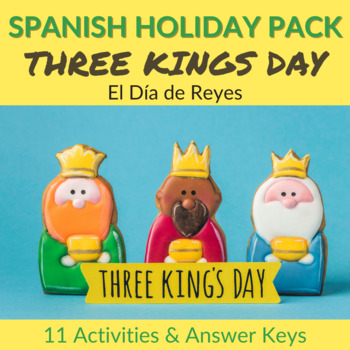For Latin America, Christmas Holidays does not end on December 25th with the celebration of the birth of Baby Jesus and Santa Claus bringing gifts to children. In fact, this is just the beginning because twelve days after Christmas, we celebrate El Día de Reyes on January 6th. This day is also known as the Epiphany, or the day that Jesus was presented to the gentiles.
 Three Kings Day Resources for Spanish Teachers
Three Kings Day Resources for Spanish Teachers
If you teach Spanish, check all our ready-made resources for your Spanish clases. We have a collection of printables to teach and practice the vocabulary for el Día de Reyes, a presentation to introduce this festivity to students, a reading comprehension activity, and an activity with the authentic son La protesta de los reyes by El Gran Combo de Puerto Rico.
Background Story About Three Kings Day
The Three Kings, Three Wise Men, or The Magi are names used in English to refer to the Tres Reyes Magos, the Tres Santos Reyes or Los Reyes. This Christian tradition came to Latin America from Spain and is based on a Bible passage from the Gospel of Mathew (Mathew 2: 1-12). This passage is very short and does not offer many details about who were these “kings from the east” that follow a star to visit the “king of the Jews” who was born in Bethlehem. That they were three kings is just speculation because of the gifts that the Kings present to the newborn child: gold, frankincense and myrrh. Five and eight centuries later, translated Greek documents started referring to the three kings with the names Melchior, Caspar and Balthazar and each one represented one of the continents known before the New World was discovered.
Since this is a famous tradition in Spanish speaking countries, here are some words that might help you understand this holiday.
Three Kings Day Vocabulary
1. Tres Reyes Magos, Tres Santos Reyes or Los Reyes: The Three Kings, Three Wise Men, or The Magi.
2. Melchor: Melchior or Melichior is the wise man that represents Europe.
3. Gaspar: Caspar is the wise man that represents Asia.
4. Baltasar: Balthazar is the black wise man that represents Africa.
5. Oro: Gold, one of the gifts presented to Jesus and was assigned to Melchior.
6. Incienso: The literal English translation is incense, but the original passage from the Bible uses the word frankincense and was the gift from Caspar.
7. Mirra: Myrrh is embalming oil from Balthazar.
8. Epifanía: Epiphany is a synonym for Three Kings Day or the Twelfth Day and means manifestation or revelation of God in the human form of Jesus.
9. Estrella de Belén: Bethlehem Star that was “followed” by the Wise Men to find Jesus.
10. Camellos: The tradition tells that the Wise Men traveled on camels. Sometimes they are shown on horses.
11. Cabalgata de Reyes: Cavalcade of Magi or Cavalcade of Three Kings is a parade celebrated the evening before Three Kings Day that represents the journey taken by the kings to visit baby Jesus.
12. Rosca de Reyes (or Roscón de Reyes in Spain): King’s cake or Three Kings Bread. This is a sweet bread in the form of a ring filled with nuts, figs and cherries and decorated with candied fruit on top. The fruit turns it into a colorful bread and looks like the gems used to decorate the Three Kings’ clothes. This treat is usually served with hot chocolate. The most interesting thing about the Rosca de Reyes is that a small figurine, which symbolizes how Jesus had to be hidden from King Herod, is baked inside. The person who finds it will host the celebration of the Día de la Candelaria (Candlemas Day) on February 2nd.
13. Zapatos: According to the tradition, leaving the shoes outside the front door, by the Christmas tree or by the Nativity scene is the key for the Wise Men to know how many children live in the house and how many gifts they should leave. There is a small variation in Three Kings Day tradition on the Caribbean islands of Puerto Rico and Dominican Republic where kids cut fresh grass and place it in a shoe box under the bed.
14. Yerba: Grass or hay put out by children on January 5th for the Three Kings’ camels to eat.
15. Nacimiento: A Nativity scene is part of the decorations placed in all houses during Christmas. This scene includes figurines of Mary, Joseph, baby Jesus and the Three Kings. More elaborate scenes include animals, camels, and shepherds.
Happy Three Kings Day!
Check out these other articles about the Spanish Language.
